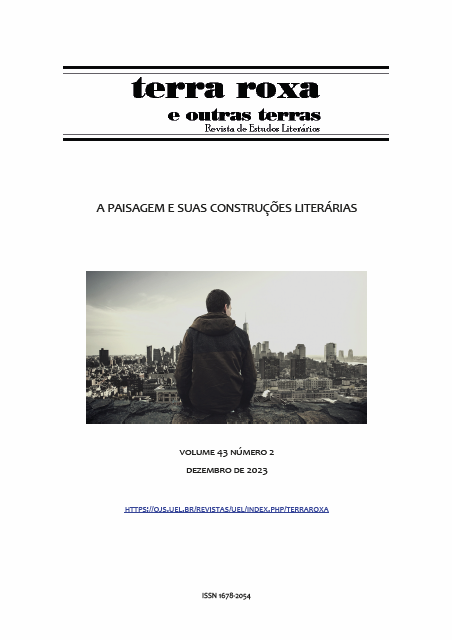The tragic use of landscape in Emily Brontë's Wuthering Heights (1847)
DOI:
https://doi.org/10.5433/1678-2054.2023vol43n2p130Keywords:
Wuthering Heights, English novel, landscape, tragicAbstract
This article discusses the tragic utilization of the natural landscape in Wuthering Heights. The primary setting of the narrative is an isolated farm in Northern England, situated atop a hill, surrounded by aridness, stones, and heather, where the climate is harsh, and the wind is constant. Emily Brontë employs elements of this landscape, such as heath, wind, and stone, to characterize the identities of her main characters, Catherine and Heathcliff, using it as a metaphor for their affinity and mutual need. This imagery contributes to the composition of the tragic events in the narrative, particularly the alienation between Catherine and Heathcliff, symbolized by their distancing from these elements. The culmination of the tragedy, brought about by the impossibility of a reunion between Catherine and Heathcliff, is also depicted through this imagery. In the novel's conclusion, heather grows over the tombstones of Catherine and Heathcliff, signifying their final integration, in death, into the landscape with which they identified.
Downloads
References
BRONTË, Emily. O morro dos ventos uivantes. Trad. Julia Romeu. São Paulo: Penguin / Companhia das Letras, 2021.
EAGLETON, Terry. Sweet Violence: The Idea of the Tragic. Oxford: Blackwell, 2003.
EAGLETON, Terry. The English Novel: An Introduction. United Kingdom: Blackwell, 2005.
COSTA, Júlia Mota Silva. Emily Brontë: paixões, natureza e moralidade. Dissertação (Mestrado em Teoria e História Literária). Instituto de Estudos da Linguagem, Universidade Estadual de Campinas, Campinas, 2022.
GIRDLER, Lew. Wuthering Heights and Shakespeare. Huntington Library Quarterly, Philadelphia, v. 19, n. 4, p. 385-392, Aug. 1956. Disponível em: https://doi.org/10.2307/3816400. DOI: https://doi.org/10.2307/3816400
GODFREY, Laura Gruber. "That Quiet Earth": Tourism, Cultural Geography, and the Misreading of Landscape in Wuthering Heights. Interdisciplinary Literary Studies, University Park, v. 12, n. 2, p. 1-15, 2011. Disponível em: https://www.jstor.org/stable/41210315. DOI: https://doi.org/10.2307/41210315
KLINGOPULOS, G. D. The Novel as Dramatic Poem (II): Wuthering Heights. Scrutiny, Cambridge, v. XIV, n. 4, p. 269-286, 1947.
LEMPRIÈRE, John. Bibliotheca classica; or, a classical dictionary. London: T. Cadell & W. Davies, 1797.
SHAKESPEARE, William. Complete Works. Jonathan Bate & Eric Rasmussen, eds. New York: The Royal Shakespeare Company, 2007.
SHAKESPEARE, William. Teatro completo. Tragédias e comédias sombrias - Volume 1. Trad. Barbara Heliodora. Rio de Janeiro: Nova Aguilar, 2009.
SWINBURNE, Charles Algernon. Emily Brontë. Miscellanies. New York: Worthington Company, 1886. 260-270. Disponível em: https://archive.org/details/miscellanies01swingoog/page/n275/mode/2up.
SZONDI, Peter. Ensaio sobre o trágico. Trad. de Pedro Süssekind. Rio de Janeiro: Jorge Zahar, 2004.
WILLIAMS, Raymond. Tragédia Moderna. Trad. Betina Bischof. São Paulo: Cosac & Naify, 2002.
Downloads
Published
How to Cite
Issue
Section
License
Copyright (c) 2023 Júlia Mota Silva Costa, Jefferson Cano

This work is licensed under a Creative Commons Attribution 4.0 International License.
Authors who publish in this journal agree to the following terms:
a) The authors retain the copyright and grant the journal the right of first publication, the work being simultaneously licensed under the Creative Commons Attribution-NonCommercial 4.0 International License, allowing the sharing of the work with acknowledgment of the authorship of the work and initial publication in this journal.
b) Authors are authorized to assume additional contracts separately, for non-exclusive distribution of the version of the work published in this journal (eg, publish in an institutional repository or as a book chapter), with acknowledgment of authorship and initial publication in this journal.
c) Authors are allowed and encouraged to publish and distribute their work online (e.g. in institutional repositories or on their personal page) after the editorial process, as this can generate productive changes as well as increase impact and citation of the published work (See The Effect of Open Access).
d) The authors of the approved works authorize the journal to, after publication, transfer their content for reproduction in content indexers, virtual libraries and the like.
e) The authors assume that the texts submitted for publication are of their original creation, taking full responsibility for their content in case of any objection by third parties.



















